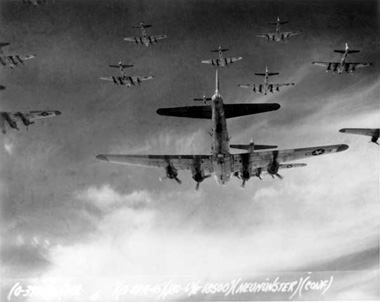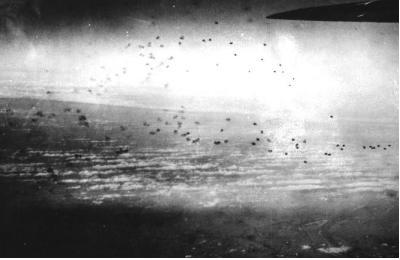
|
"Der Grosse Schlag" The Luftwaffe's Great Blow by Raul Colon |
||
|---|---|---|---|
| Home Page | Articles Index | ||

|
|||
|
The 8th Air Force heads towards Germany. | |||
|
As the summers months of 1944 passed, giant Allied Air Armadas bombed the German homeland. In daylight bombing runs, the US 8th Air Force pounded away at Germany's centers of communication, industry and troop build-up, then at night, the full force of Britain's Bomber Command descended upon Germany’s cities and towns. Germany’s Air Force, the once vaunted Luftwaffe, tried as best as it could to stem the tied of this massive offensive, but with scare resources committed on a prolong two front war, it was almost impossible for the Luftwaffe to impede the Allied bombing strategy.
What would be expected that on that day—the skies might be clear, or would an overcast scuttle the whole operation? For the German plan to have any chance at success, every detail would have to be planned and rehearsed many times over. One area in particular that worried the high command was the shortage of experienced formation leaders. Normal individual Gruppen or squadrons, earmarked for The Great Blow had been expanded, in some instances to twice their normal strength in both aircraft and pilots. With this in mind, it would be necessary to recruit the best trainers from the whole German Air Force. Another factor that had to be contended with was the limited supply of aviation fuel available for training. Also, Hitler needed to be told of the operation before it could get off the ground—this added to the suspense that the operation might be terminated before the operation was even to begin. |
 |
|
|
On the way to the Leuna-Merseburg oil refinery, flak filled the sky. |
| On November 2nd, 1944, the Luftwaffe was ready to test its theory of a massive concentrated attack on bomber formations coming from England. Ten squadrons, totaling some 490 fighters took off to engage 1,000 American bombers, escorted by 873 fighters. The US mission—to pulverize the Leuna-Merseburg oil refinery and rail central communication hub. However, instead of a Great Blow, the attack was more of a great disappointment. The Luftwaffe had put some pressure on the Allied formation, but the presence of US escort fighters put a damper on the attack. At the end of the day, some 120 German fighters were shot down, but more importantly to the Germans, 98 experience fighter pilots were lost in the attack. An attrition rate they could not sustain this late in the air war. With the high cost in both men and machines, came the realization that the operation, just cost too much to the Germans Fighter Force, and with only 40 bombers destroyed—just 3.6 per cent of the entire bombing armada. The American losses were sustainable—they could replace aircraft and crews, within a day or two. The failure to inflict an anticipated heavier damage to the US bombers on November 2nd, did not bode well for The Great Blow strategy. |

|
|
8th Air Force losses were not as high as expected by the Luftwaffe. |
|
Hitler immediately requested detailed information of the future attack. He then reasoned that if Fighter Force could mount such a massive forced for The Great Blow, he could amass the same force for another intention. His last grasp at victory—"Wacht am Rhine", or "Watch on the Rhine"—a proposed attack by the last of the German Army elite units, the Panzers. For this new endeavor, Hitler would deploy his last available offensive capability, seven top-of-the-line Panzer divisions, numbering some 200,000 men in an effort to smash through the Ardennes sector of the US front and making a rapid attempt to capture the port city of Antwerp. He believed that such an attack, at a time when Germany’s enemies thought their military machine was exhausted, was likely to catch them off balance. Above all, Hitler was playing for time—time to introduce to the world, his new advanced aircraft and U-Boats and extend the war—for he also believed that the irreconcilable political systems of the Western Allies and the Soviet Union would lead to their falling out, and eventually even perhaps start fighting amongst themselves. A recurring theme for the German propaganda machine at the time.
So, in accordance to this thinking, Galland received in mid November 1944, an order to prepare the great concentration of airplanes and pilots, he so painstakingly had assembled, his pick of the best Fighter Forces, and prepared them to support a great land battle in the west. On November 20th, the official cancellation order for The Great Blow was received at Galland's headquarters. He tried to stress to the High Command that all preparations made for The Great Blow were for an attack by massive fighters formations on an incoming enemy, from established airfields in central Germany, not the rough-and-tumble operations from small fields close to the front, but these objections fell on deaf ears. Hitler had made his call. So ended the last grand stand of the once mighty Luftwaffe. |
Sources
|
History of the German Night Fighter Force 1917-1945, Jane’s 1978 Six Months to Oblivion, Ian Allan 1975 The Last Year of the Luftwaffe: May 1944 – May 1945, Alfred Price 2001 |
|
The author Paul Colon is a freelance writer who resides in San Juan Puerto Rico. rcolonfrias@yahoo.com |
Return To Articles Index.
© The Aviation History On-Line Museum.
All rights reserved.
November 29,2007.
